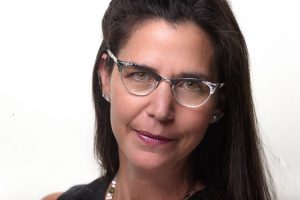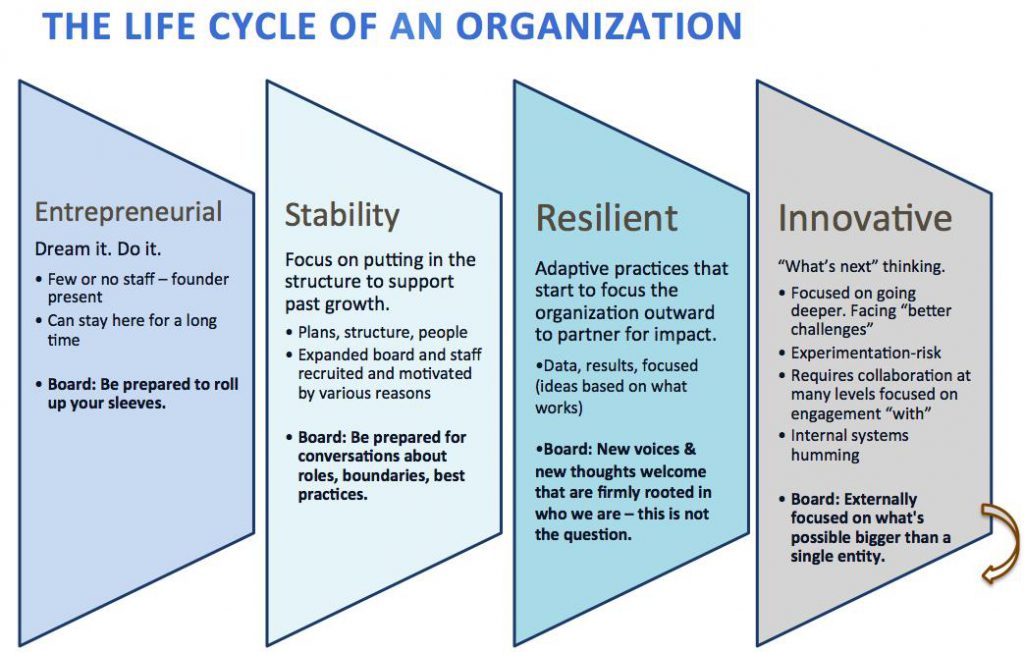


Latest news, alerts, and events.
Latest news, alerts, and events.
 Do you wonder why some decisions seem better timed than others? Or why the expectations of some board members about their service do not fit with the discussions and activities the team needs today? Do you wish your board or staff would see why your line of questioning makes so much sense right NOW in your organization? When you are in a planning session do you struggle to find the balance between internal and external focus in your goals, or find that the board is holding you and your staff back from taking on new goals that would propel the mission forward?
Do you wonder why some decisions seem better timed than others? Or why the expectations of some board members about their service do not fit with the discussions and activities the team needs today? Do you wish your board or staff would see why your line of questioning makes so much sense right NOW in your organization? When you are in a planning session do you struggle to find the balance between internal and external focus in your goals, or find that the board is holding you and your staff back from taking on new goals that would propel the mission forward?
We hear about these tension-filled scenarios a lot, but unfortunately there is little science to give us the answers to eliminate the tension. More often, the gift instead is asking these questions out loud and creating constructive conversations to go with them. Maybe it is even like going to a fortune teller and holding out your hand – the power is in taking the step to ask the questions and the opportunity is to explore the answers.
Since palm reading is not on the menu of services at Foraker, I started working on a tool to help jumpstart these kinds of conversations for board and leadership staff. What emerged is a new life cycle framework. We have not abandoned the other frameworks, including the one based on founders or the version that takes the life cycle from the perspective of a high performing board that we share in our courses. Instead, this is complementary to that work. This framework focuses on the tensions that drive our decisions and explores the environment that supports one kind of decision over another. This framework is not final, but rather a work in progress. My hope in sharing it with you is to spark conversation and inspire action.
First, let’s establish some general “rules of the road” when describing the nonprofit life cycle.
With these caveats in mind, let’s look at a high-level view of the stages. You can refer to the diagram below that visualizes our thinking.

Entrepreneurial: Dream it. Do it.
Perhaps this is the most straightforward phase – most of our organizations have been here or are still here. This phase has superhuman qualities to it. If you dream it, you can do it. Since we start here, it is no accident that the founder is usually present and with that person comes the extraordinary energy, drive, and commitment to a particular definition of mission. There may be staff here, or not. Regardless, the defining moment for everyone on the team is “roll up your sleeves” and dive in. This stage works best when everyone is deeply grounded to purpose and values, and the ideas, projects, and directions come from this place – otherwise the work feels hard and long. You might know this opposite experience when all the creative ideas make everyone but a few feel dizzy and exhausted. Organizations can stay in this positive or challenging phase for a long time. The shift to the next phase often happens when at least one factor appears: 1) the founder or core team leaves, 2) a funder or outside influencer requires internal structure and accountability that does not exist, or 3) there is an overwhelming feeling from the internal team that everyone is working harder, not smarter. In these moments the shift occurs.
Stability: Focus on putting together the structure to support past growth.
Some love this place, others dread it. If you thrived in an entrepreneurial space this phase may not be your comfort zone. Others of you will breathe an audible sigh of relief – “Ahhhh structure.” In this phase, we love planning documents, we love putting the foundation of policies, procedures, tools, and people under all that we have created. We get to have conversations about roles and responsibilities for board and staff often for the first time, and many more times after that. We get to think about process, not just results. We also get new people – both on the board and on staff – which can be equal parts relief and a huge challenge. A note of caution, too many people focused on policy and structure can pull all the joyful energy that got us here from our entrepreneurial days. We need a diversity of ideas, perspectives, and energy in this phase. Again, aligning to our values and culture is key to any new recruitment and retention with an eye to understanding that we need new skills at the table for those who care deeply about who we are. Bottom line, we are building capacity in this phase with best practice tools. We will keep this skill set and desire for strength as we move into the next phases of our life. And, if we are focused enough, we will move forward with renewed energy.
Resilient: Adaptive practices based on what works
We get to this stage by being creative and having some systems. Now we want to know what works. This stage of our life cycle is all about focusing on our data and knowing, truly knowing our results. This stage is about asking questions, entertaining new ideas, keeping what works, and letting go of things that no longer work. The caveat to this stage is that it doesn’t work out very well for the person on the team who forgets all the hard work that just went into getting us here. New ideas and thoughts are welcome, but not at the risk of undoing what is core and not just because someone “thought” it would work. In this phase we want proof. We want data and the systems that hold the data. The challenge is turning data into information, then into knowledge and, critically important, into action. Data itself is not the point, and we can get stuck here or we can use it to launch ourselves into what comes next.
Innovative: “What’s next” thinking.
It is likely by this stage that we are old enough to have many pieces in place. It is not perfect, it never is. But most things work, or we have a process for building our capacity in the areas that need work. So now we take our purpose, our values, our plans, our data, and we look outward. In the resilience stage, the focus is still mostly inward on the organization or the mission. In this phase, we don’t give that up entirely, but instead use that information to ask new questions about the bigger issues and challenges that encompass our mission. The good news is that the team is more open to seeing how critical it is to collaborate. Not just in the “I’m okay, your okay – I know you exist, you know I exist” kind of way we may have experienced previously, but in real partnerships focused on getting better results. Importantly, this stage stops being about the organizational structure and begins to be about the resilience of mission. The institution is just a vessel that currently holds the work together. Our definitions of success are expanded and our tolerance for calculated risk grows in the name of finding deeper and multifaceted external relationships so that we can find deeper and better solutions to our most complex challenges. In our board rooms and with our staff, we are asking not just what we can do and what we can offer to a larger system, but we are asking what we can’t know alone and what is possible when we work “with” rather than “at” or “for.” The gift of this stage can be our greatest challenge – the work is not linear, and it requires many perspectives that challenge our assumptions. This stage is sought after, but generates a lot of discomfort. The reward is progress in mission in a new way that can bring us all the way back around to the entrepreneurial stage either in a new system or a new structure.
These are just snapshots. There is more to say about each phase and more gets said by every group that decides this is the conversation they want to have together. In these conversations, I have seen insights about how the CEO is in one place and the board in another. I have seen a deep desire to move to a new phase by many, but a few hold them back because of fear. I have seen some dip a toe into one space and come back to their comfort zone. People run missions and people do amazing things, some of that is helpful and some is not right now. Such is life. And, just like that life line in your palm, the more you explore the more your opportunity for curiosity, conversation, and contemplation. There isn’t right or wrong, good or bad. There is just your organization on a journey. What does your palm say? Are you ready to have this conversation? How will it and the insights it brings drive your decisions? Let us know where you are going next.